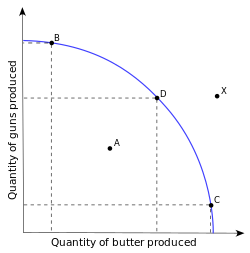Productive efficiency
This article needs additional citations for verification. (May 2010) |


Productive efficiency is a situation in which the economy could not produce any more of one good without sacrificing production of another good. The concept is illustrated on a production possibility frontier (PPF), where all points on the curve are points of productive efficiency.[1] An equilibrium may be productively efficient without being allocatively efficient— i.e. it may result in a distribution of goods where social welfare is not maximized.
Productive efficiency requires that all firms operate using best-practice technological and managerial processes. By improving these processes, an economy or business can extend its production possibility frontier outward, so that efficient production yields more output than previously.
Productive inefficiency, with the economy operating below its production possibilities frontier, can occur because the productive inputs physical capital and labor are underutilized—that is, some capital or labor is left sitting idle—or because these inputs are allocated in inappropriate combinations to the different industries that use them.
In long-run equilibrium for perfectly competitive markets, productive efficiency occurs at the base of the average total cost curve—i.e. where marginal cost equals average total cost—for each good.
Due to the nature and culture of monopolistic companies, they may not be productively efficient because of X-inefficiency, whereby companies operating in a monopoly have less of an incentive to maximize output due to lack of competition. However, due to economies of scale it can be possible for the profit-maximizing level of output of monopolistic companies to occur with a lower price to the consumer than perfectly competitive companies.
References
- ^ Standish, Barry. Economics: Principles and Practice. South Africa: Pearson Education. pp. 13–15. ISBN 978-1-86891-069-4.
